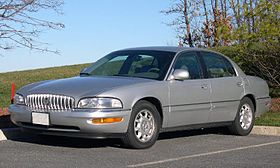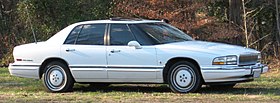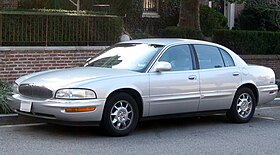Buick Park Avenue
| Buick Park Avenue | |
|---|---|
 | |
| Overview | |
| Manufacturer | Buick (General Motors 1991-2005) Shanghai GM (2007-2012) |
| Production | 1990–2005 (U.S.) 2007–2012 (China) |
| Model years | 1991–2005 (U.S.) 2007–2012 (China) |
| Body and chassis | |
| Class | full size luxury car |
| Body style | 4-door sedan |
| Layout | Transverse front-engine, front-wheel drive (1991–2005) FR layout (2007–2012) |
| Chronology | |
| Predecessor | Buick Electra Buick Royaum (China) |
| Successor | Buick Lucerne |
The Buick Park Avenue is a full-size luxury car built by Buick. The nameplate was first used in 1975 for an appearance option package on the Electra 225 Limited. It became an Electra trim level in 1978 and its own model starting in the 1991 model year after the Electra was discontinued. There were two generations of the Park Avenue that were manufactured in the United States until 2005. In 2007, the nameplate was revived on a large Buick sedan built by Shanghai GM for the Chinese market based on the Holden Caprice from the WM/WN range. The nameplate is derived from the affluent New York City boulevard, Park Avenue.
As a sub-model (1975-1990)[]
1975-1976
Park Avenue first appeared as an appearance package on the 1975 Buick Electra Limited. It included similar seats to the Cadillac Sixty Special, optional full center console, Buick 455ci V8, posi-traction, 15" rallye sport wheels, rear automatic leveling, optional leather, optional Air Cushion Restraint System, remote mirror with thermometer, and automatic climate control. The 1976 cars were largely the same except for some styling revisions and added emissions systems.[1][2] [3][4]
1977-1984
Park Avenue, previously an appearance option package, became an official trim level on the Electra in 1978. Cosmetically, a different grille and redesigned tail lights were the only notable cosmetic changes that year but 1979 brought a redesigned, flat front end and a subtly different taillight treatment featuring a Buick crest and bisecting horizontal silver line. A more extensive redesign occurred for the 1980 model year.[5][6][7][8]
1985-1990
Park Avenue remained the top trim on the Buick Electra, it was redesigned along with the rest of the Electra line up moving to the front wheel drive GM C-Body. It featured upgraded upholstery/seating, premium sound, optional leather, and standard Buick 3800 V6.[9][10][11] The coupe version was discontinued in 1987. For 1989, Buick introduced the Park Avenue Ultra trim level. The Ultra was essentially an upgrade to the Electra Park Avenue line, and featured a standard leather interior with dual 20-way power front seats (shared with Cadillac's restyled 1989 Cadillac Fleetwood Sixty Special), lower-body accent exterior paint treatment, distinctive thick-padded vinyl top with limousine-style rear-window surround (available only on Ultra), simulated burled elm trim on the doors and instrument panel, unique aluminum wheels, anti-lock brakes, chromed B-pillar moldings, specific grille and tail lamps, leather-wrapped steering wheel, electronic instrumentation, padded glove-compartment door, unique interior door panel trim, and a variety of otherwise minor changes. With its long list of standard equipment, the Park Avenue Ultra carried a higher base price than Cadillac's Sedan de Ville. The Park Avenue Ultra did not gain much popular recognition, however, until the following generation of Park Avenue where the "Ultra" badge offered even more features.[12]
Essence concept car[]

The Buick Park Avenue Essence was a concept car designed and engineered by the Buick division of General Motors to showcase advanced technology and styling. First shown in 1989 in a light green metallic color, the Essence made rounds through the auto show circuits later in a light white. Inside the Essence was a wide, sweeping instrument panel that housed a prototype Delco Navicar navigation system among other innovations. Smooth, graceful body lines forecast the eventual production Park Avenue, introduced in 1990. The Essence was powered by the then-new 165 hp version of Buick's 3800 OHV V6 engine.
First generation (1991–1996)[]
| First generation | |
|---|---|
 | |
| Overview | |
| Type | Passenger car |
| Manufacturer | Buick |
| Production | 1990–1996 |
| Model years | 1991–1996 |
| Assembly | Hamtramck, Michigan, United States Lake Orion, Michigan, United States Wentzville, Missouri, United States |
| Designer | Dave Holls (1988)[13] |
| Body and chassis | |
| Body style | 4-door sedan |
| Layout | Transverse front-engine, front-wheel drive |
| Platform | C-body |
| Related | Buick LeSabre Cadillac Sixty Special Cadillac Fleetwood Cadillac DeVille Cadillac Seville Oldsmobile 98 Pontiac Bonneville |
| Powertrain | |
| Engine | 3800 V6 Series I L27 NA (91-94) 3800 V6 Series I L67 SC (91-94) |
| Power output | L27 series I: 170 hp (91-94) L36 series II: 205 hp (95-96) L67 series I: 205 hp (91-93) L67 series I: 225 (94-95) L67 Series II: 240hp (96) |
| Transmission | 4-speed 4T60-E automatic |
| Dimensions | |
| Wheelbase | 110.8 in (2,814 mm) |
| Length | 1991–93: 205.2 in (5,212 mm) 1994–96: 205.9 in (5,230 mm) |
| Width | 1991–93: 74.9 in (1,902 mm) 1994–96: 74.1 in (1,882 mm) |
| Height | 1991–93: 55.3 in (1,405 mm) 1994–96: 55.1 in (1,400 mm) |
| Curb weight | 3,536 lb (1,604 kg) |
| Chronology | |
| Predecessor | Buick Electra |
The 1991 Park Avenue, introduced in July 1990, utilized GM's C platform. It was previewed by the 1989 Park Avenue Essence show car and the Park Avenue's silhouette was often compared to that of contemporary Jaguars and many of its styling cues, which included a large 'dollar-grin' grille mounted to the hood, rounded lines, and full-width tail lamps. These styling cues made their way to other Buick models restyled in the 1990s. The Park Avenue was Buick's largest front wheel drive sedan, but the even larger rear wheel drive Roadmaster returned to the lineup in 1991 for the station wagon and 1992 for the sedan. While not the largest vehicle offered by Buick, as that distinction belonged to the Roadmaster, the Park Avenue was the most luxurious and considered the flagship of the marque. This generation saw the installation of Dynaride, which was an air compressor that would pressurize the rear Chapman Struts to maintain a level overall ride height. A badge was installed on the dashboard to the left of the steering column on all vehicles equipped. It was not available on vehicles equipped with Gran Touring Suspension.
The base model Park Avenue came with a 3.8 L naturally-aspirated V6 engine and plush velour interior upgradeable to leather. Starting in 1992, the Ultra came with a 3.8 L Supercharged V6 engine and standard leather interior. The Park Avenue received various exterior and interior cosmetic changes, as well as powertrain updates, during this run. Some of the new options and features added to the first generation included driver (and later passenger) airbags, dual zone climate control, traction control, and variable-effort steering (Ultra only).
European Market[]
The Park Avenue was available in Europe from 1991 to 1996 and varied from the North American version by featuring a truncated taillamps with separate amber turn signal indicators and red brake lamps, wider numberplate bezel, fitment of rear red fog lamps, headlamps with different lens pattern, white front side running markers, amber front turn signal indicators, side turn signal repeaters, "flagpole" external rear-view mirrors (mirrors on US version are fixed and do not turn), stronger seat belt and anchors, "softer" air bags, metric speedometer and gauges. They are to comply with the European regulatory and safety standards. This generation of the Park Avenue was the last Buick to be officially marketed by GM in Europe. This move was to reduce the "cluttered" model range that confused the European consumers. After 1996, Cadillac and Chevrolet remained the sole General Motors North American brands to be sold in Europe.
Second generation (1997–2005)[]
| Second generation | |
|---|---|
 | |
| Overview | |
| Production | 1996–2005 |
| Model years | 1997–2005 |
| Assembly | Hamtramck, Michigan, United States Lake Orion, Michigan, United States |
| Designer | Bill Porter[14] |
| Body and chassis | |
| Body style | 4-door sedan |
| Layout | Transverse front-engine, front-wheel drive |
| Platform | G platform[15] |
| Related | Buick Riviera Oldsmobile Aurora Cadillac DeVille Cadillac Seville Buick LeSabre Pontiac Bonneville |
| Powertrain | |
| Engine | 3.8 L Buick V6 (Series II) 3.8 L Buick V6 (Series II Supercharged) |
| Transmission | 4-speed 4T65-E automatic 4-speed 4T65-E HD automatic |
| Dimensions | |
| Wheelbase | 113.8 in (2,890 mm) |
| Length | 206.8 in (5,250 mm) |
| Width | 74.7 in (1,900 mm) |
| Height | 57.4 in (1,460 mm) |
| Curb weight | 3,778–3,884 lb (1,714–1,762 kg) |
An updated Park Avenue was released in October 1996 as a 1997 model and was now built on GM's G platform; however GM chose to continue to refer to it as the C platform, but was stronger and more substantial than its predecessor.[16] This new generation was powered by updated Series II variants of the 3800 and as before, only Ultra models were supercharged. The base trim featured a hood ornament while the Ultra had a less conspicuous tri-shield inset on the upper edge of the grille. The base Park Avenue was the last USDM Buick to carry a factory hood ornament.
For 2001, the base model's cloth interior was dropped as an option in favor of now standard leather trim. Ultrasonic rear park assist was a new option that year as well. For 2003, trademark Buick "Ventiports" returned on the Park Avenue Ultra along with a bolder grille that carried a larger monochromatic tri-shield badge in the center. New 17 inch wheels, a revised interior and revised instrument cluster were changed for the 2003 model year on the Ultra.
For 2005, the final model year in North America, base Park Avenues received a revised grille, and the previously Ultra-exclusive Ventiports. Also, the rear fascia was redone across the model line with a prominent chrome bar above the license plate holder with an embossed Park Avenue script and amber turn signal flashers.
The last 3,000 of 7,000 Park Avenues carried Special Edition badging that featured the namesake script underneath a silhouette of the New York City skyline. 300 of these were painted with a special two-tone black-on-platinum finish. Production ended on June 18, 2004.[17] The Park Avenue was discontinued after 2005 in the North American market and was replaced in 2006 by the Buick Lucerne.
Third generation (2007–2012)[]
| Third generation | |
|---|---|
 | |
| Overview | |
| Manufacturer | GM Shanghai |
| Also called | Holden Special Vehicles Grange/Senator Holden Caprice/Statesman Chevrolet Caprice Daewoo Veritas HSV Grange Bitter Vero |
| Production | 2007–2012 |
| Assembly | Elizabeth, South Australia (All Parts) Shanghai, China (Final Assembly) |
| Designer | James C. Shyr (2007; interior) |
| Body and chassis | |
| Body style | 4-door sedan |
| Layout | FR layout |
| Platform | GM Zeta platform |
| Related | Holden Commodore Pontiac G8 Chevrolet Camaro Chevrolet Lumina |
| Powertrain | |
| Engine | 2.8 L LP1 V6 3.0 L LF1 V6 3.6 L LY7 V6 |
| Transmission | 5-speed GM 5L40E automatic (2007–2009) 6-speed GM 6L50E automatic (2010–2012) |
| Dimensions | |
| Wheelbase | 3,009 mm (118.5 in) |
| Length | 5,175 mm (203.7 in) |
| Width | 1,899 mm (74.8 in) |
| Height | 1,480 mm (58.3 in) |
| Chronology | |
| Predecessor | Buick Royaum |

In April 2007, General Motors reintroduced the Park Avenue nameplate in China on a luxury sedan that replaced the Buick Royaum. Like its predecessor, the vehicle is based on the Australian-built Holden Caprice (this time on the contemporary WM/WN generation), though, unlike the Royaum, it was assembled by Shanghai GM from CKD kits shipped from Holden's Elizabeth factory in South Australia.[18] It is offered in five trim levels: 舒适型 (Comfort), 精英型 (Elite), 豪华型 (Luxury - 2.8 only), 旗舰型 (Flagship) and 旗舰版 (Ultimate - 2010 only)
The Park Avenue was powered by Australian-built versions of the GM High Feature engine. The standard engines were the 2.8 L LP1 and the 3.6 L LY7 engine available as an option on the Elite and Flagship models from 2007 to 2009. The engine control unit is a Bosch E77 32-bit ECM processor.[19]
| Type | Displacement | Power | Torque | Model years |
|---|---|---|---|---|
| 2.8 L LP1 V6 | 2,792 cc (170 cu in) | 150 kW (201 hp) at 6500 rpm | 265 N⋅m (195 lbf⋅ft) at 2600 rpm | 2007–2009 |
| 3.6 L LY7 V6 | 3,564 cc (217 cu in) | 187 kW (251 hp) at 6600 rpm | 340 N⋅m (251 lbf⋅ft) at 2800 rpm | 2007–2009 |
| 3.0 L LF1 V6 | 2,994 cc (183 cu in) | 187 kW (251 hp) at 6700 rpm | 296 N⋅m (218 lbf⋅ft) at 2900 rpm | 2010–2012 |
In 2010, only one engine option was offered, a 3 L SIDI (251 bhp) replacing the old 2.8 V6 and 3.6 V6 due to fuel consumption with the 2.8 litre engine rated at 11.4 litres per 100 kilometres (20.6 MPG US) and the 3.6 litre engine rated 11.6 litres per 100 kilometres (20.3 MPG US) respectively. The 3 litre engine was rated 10.9 litres per 100 kilometres (21.6 MPG US). The third-generation Park Avenue remained a China exclusive and was never offered by Buick in North America. A version of the car did eventually see release in the US market as the stripped down, rebadged Chevrolet Caprice PPV (Police Patrol Vehicle).
It was discontinued in China in October 2012.[20]
References[]
- ^ "1975 Buick". www.lov2xlr8.no.
- ^ "1975 Buick". www.lov2xlr8.no.
- ^ "Photo" (JPG). www.lov2xlr8.no. Retrieved 2019-08-09.
- ^ "1975 Park Ave Executive Deluxe Prototype". V8buick.com.
- ^ "Auto Brochure". www.lov2xlr8.no.
- ^ "Photo" (JPG). www.lov2xlr8.no. Retrieved 2019-08-09.
- ^ "Photo" (JPG). www.lov2xlr8.no. Retrieved 2019-08-09.
- ^ "Photo" (JPG). www.lov2xlr8.no. Retrieved 2019-08-09.
- ^ Klockau, Tom. "Curbside Classic: 1985 Buick Electra Park Avenue – Best-Dressed C-Body Of The Year".
- ^ "Photo" (JPG). www.lov2xlr8.no. Retrieved 2019-08-09.
- ^ "lov2xlr8.no". www.lov2xlr8.no.
- ^ "Brochures". www.lov2xlr8.no.
- ^ Lamm, Michael. "Dave Holls, who led GM design, dies". Retrieved 16 October 2016.
- ^ "1997 Buick Park Avenue". Retrieved 17 October 2017.
- ^ Frame, Phil (16 January 1995). "GM H CARS MOVE TO G PLATFORM". Automotive News. Archived from the original on 16 June 2013. Retrieved 17 May 2013.
- ^ Frame, Phil (16 January 1995). "GM H CARS MOVE TO G PLATFORM". Automotive News. Archived from the original on 16 June 2013. Retrieved 17 May 2013.
- ^ "Buick Park Avenue". CarGurus.
- ^ Dornin, Tim (11 April 2007). "WM Statesman derived Buick to be assembled from CKD kits and sold in China". Fairfax Media. Archived from the original on 16 August 2013. Retrieved 15 April 2007.
- ^ Nunez, Alex (10 April 2007). "Buick reintroduces the Park Avenue...in China". Autoblog.
- ^ "Buick Park Avenue Is Coming to an End". ChinaAutoWeb. 22 October 2012. Retrieved 2 September 2014.
External links[]
![]() Media related to Buick Park Avenue at Wikimedia Commons
Media related to Buick Park Avenue at Wikimedia Commons
- 1991-1996 Buick Park Avenue: Overview
- 1997-2005 Buick Park Avenue: Overview
- Buick official page: China
| show |
|---|
| show |
|---|
- Buick vehicles
- Front-wheel-drive vehicles
- Full-size vehicles
- Sedans
- Motor vehicles manufactured in the United States
- Cars introduced in 1990
- 2000s cars
- Park Avenue

